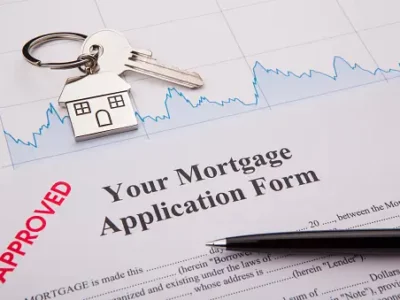Understanding the Basics of a Mortgage
In the dog-eat-dog world of securing a home loan, understanding the basics of a mortgage is as important as remembering your ABCs. In a nutshell, a mortgage is a loan you take from a lender, typically a bank or credit union, to purchase a home, with the home itself serving as collateral. That’s the meat and potatoes of it, but there’s so much more to chew on. One of the key ingredients you need to be aware of is private mortgage insurance, widely known as PMI. Hold on to your hat, homeowner, because here’s where it gets sticky! With a conventional mortgage, if you put down less than 20% of the home’s purchase price, the lender may require PMI to protect themselves from potential default on your loan.
This type of mortgage insurance has an annual premium that’s calculated as a percentage of your loan amount and is typically paid monthly, adding to your monthly mortgage payment. The borrower pays these costs until they have 20% equity in their home, at which point, thanks to the federal homeowners protection act, they can cancel pmi. FHA loans, backed by the U.S Federal Housing Administration, come with their own set of quirks. They require both an upfront mortgage insurance premium of 1.75% of the loan amount per year and an annual mortgage insurance premium, based on the LTV ratio, size and duration of the loan, payable monthly. It’s like your lender has two hands in your pocket!
Now, don’t go crying in your coffee yet. Paying PMI on a conventional loan might feel like a pinch now, but it can help you qualify for a larger loan or buy a home sooner than you could otherwise. Weigh your options, work out the costs and consult with multiple mortgage lenders to land the best deal.
Impact of Private Mortgage Insurance on Mortgage Approval
Well, buckle up, homebuyer! The world of mortgages can be a rough ride, especially when it comes to understanding the impact of Private Mortgage Insurance (PMI) on your mortgage approval. As you’re ‘shopping for a mortgage’, you might hear the rattling of terms like PMI and wonder, “What’s all the fuss about?” Well, dear friend, PMI, like a nagging mosquito, can be persistent, but it’s nothing you can’t handle.
To put it in simple terms, PMI is a type of policy that protects the lender if you, the borrower, can’t keep current on your payments. Picture it this way — you’re trying to thrust your foot in the door of homeownership but stumble because you can’t ‘make a down payment’ of more than 20% of the home’s value. Now, who’s going to cover the lender’s back if you default? That’s right, PMI swoops in like an unsung hero. Now, while opting for this insurance gives you the advantage of making a ‘low down payment’, it’s akin to playing with fire without a safety net. PMI payments, heavens above, can cause the ‘payment amount’ of your mortgage to skyrocket, and bam, you’ll be stuck with a ‘higher interest rate.’ The PMI rate varies but it can tack on a significant ‘monthly premium’ to your mortgage loan balance. It’s worth remembering that Beware of the bait! Mortgage insurance isn’t always a staple for all mortgage loans. Conventional mortgage borrowers, for instance, can ‘avoid PMI’ if they can cough up a ‘larger down payment’.
- Let’s talk turkey — the ‘cost of PMI’ becomes relevant when you ‘put down less than 20%’ of the purchase price. In this case, you’re ‘required to pay’ PMI until you reach that magical 80% mortgage balance. If your credit score is lower, there’s every chance you’ll pay a higher premium. Good grief, what a rollercoaster!
- Although FHA mortgage loans are backed by the Federal Housing Administration, the ‘mortgage insurance costs’ don’t fade away like a summer frost. FHA borrowers have to ‘pay MIP’, which includes a 1.75% ‘payment at closing’ and an annual MIP throughout the ‘life of the loan’.
So, how can you put PMI behind you? I hear you ask. Well, once you’ve built enough equity, you can ‘refinance into a conventional loan.’ Chevy to the levy, my friend! Do the math, evaluate how ‘much is mortgage insurance’ adding to your loan, and how ‘much you’ll pay’ once you refinance. Don’t forget to factor in the ‘mortgage insurance fee’ and the ‘refinance’ costs. Also, remember that a good ol’ ‘Department of Veterans Affairs’ loan or a loan through the National Association of Realtors don’t ‘require mortgage insurance’. Make an educated decision and you could have the sun shining on your homeownership journey. It’s high time to save some bucks!
How to Pay for PMI
Well now, PMI, or Private Mortgage Insurance, can feel like a hitch in your giddy-up when you’re shopping for a mortgage. It’s a necessary evil if you’ve got less than 20 in your back pocket for a down payment and lenders require mortgage insurance to protect their investment. You may be thinking, “how on earth do I pay for this added monthly premium?” Take a deep breath, and read on. PMI might have you paying a higher interest rate, but don’t let the cost of PMI bring you down; it’s possible to nudge those mortgage insurance costs lower if you play your cards right.
First off, you could aim to make a bigger down payment. It may sound like a pipe dream, but scraping together a larger down payment could lower the payment amount you need to pony up for PMI. If you’re able to reach or surpass the golden 20 mark, you can dodge PMI entirely, even with loan programs that traditionally require mortgage insurance. Valley folks with lower credit scores might face higher interest, but there are plenty options to help bring down the mortgage insurance fee. For instance, The Department of Veterans Affairs and other loan programs allow for lower down payments without PMI.
These choices could help your costs go down in the long run:
- Pay off the loan faster
- Refinance into a conventional loan if you can earn a lower cost of mortgage insurance
- Choose a type of PMI that is paid at closing rather than monthly
Don’t be surprised if you also have to pay an annual MIP (Mortgage Insurance Premium) of 1.75 of the loan amount. This fee can be paid at the closing itself, or rolled into the life of the loan. But remember, the aim of the game is to reduce how much you’ll pay for mortgage insurance across the board. So even if you have to put down less than 20 initially, keep your peepers open for opportunities to avoid PMI and potentially blot out the need for MIP payments altogether. Refinancing might be your best bet. If you hold more than 20 equity in your home (in other words, if your loan to value ratio is less than 80), you may be able to dodge the bullet and won’t have to pay for private mortgage insurance. We know the path may be twisted, but don’t expect to pay through the nose forever. Grit your teeth, knuckle down and pretty soon, you’ll be seeing the light at the end of the tunnel.
The Role of Insurance Rate in Conventional Loan
Hold onto your hats, folks, ’cause we’re about to dig into the nitty-gritty of insurance rate’s role in conventional loans. Mortgage insurance, dear reader, is not only your safety net, but also a magic carpet that can help you soar to great heights, i.e., homeownership. With it, should you find yourself unable to pull out the big bucks when the bank comes knocking, you’ve got a handy backup. But, wait, there’s more! Let’s chew on some tasty nuggets of knowledge, shall we?
Shelling out a low down payment, while mightily tempting, does come with a catch, and it’s called mortgage insurance. You see, banks need to cover their bases, right? So, if you cough up less than 20% of the property’s value upfront or “cover 80,” you’ll be required to pay – hang on, don’t fall over your chair – the cost of mortgage insurance. Well, how much is mortgage insurance, you wonder? Without mincing words, costs will go up if your down payment is slimmer than a shoestring. And, brace yourself, not only do you need to pay MIP each month, but you’ll also need to make a nifty payment at closing. There’s not moseying around this loan unless you put a hefty sum down on the table. Now, don’t go turning all shades of green thinking about this, remember, mortgage insurance can help cover you when the going gets tough.
How to Cancel PMI and Lower Monthly Payments
Hey there, fed up with those high monthly payments, right? Then, it’s time you got to know about ditching your PMI to ease the burden a bit. PMI, for those not in the know, is Private Mortgage Insurance, one of those pesky little additions to your mortgage bill when you don’t make a down payment that’s hefty enough. Seriously, who actually has 20% of a property’s value just lying around? So, as handy as PMI can be in getting you on that property ladder, eventually, there’ll come a time when you’re more than ready to see the back of it!
Now, how to cancel this so-called PMI, you ask? Well, my friend, it’s not exactly a walk in the park, but with a solid game plan, it is achievable. First things first, you’ll have to pay down your mortgage balance to 80% of your original appraised value. Oh boy, yep, this means putting hard cash down the drain (or so it feels) to lower that outstanding balance. You also need to be up-to-date with your mortgage payments, no lates or delinquents unfortunately. Lastly, fire up that determination of yours to convince the lender that your property has not declined in value. As challenging as this sounds, remember ultimately it can lead to lighter monthly payments and isn’t that worth a shot? Just keep your eyes on the prize!
Conclusion
In conclusion, embarking on a significant purchase such as a home or a car often requires the buyer to make a down payment. This initial upfront partial payment showcases commitment and facilitates trust between the buyer and seller. In most cases, the down payment is a fixed percentage of the total cost of the item and can be negotiated depending on the seller’s terms. Following this, there are usually subsequent payments to cover the remaining cost of the item. More often, an agreement is established between the buyer and seller on how these payments will be made. It is important to understand that this isn’t the end; it’s merely the beginning of the financial obligation. As a buyer, you’ll have to pay the remaining amount in installments. Depending on the agreement, these could be monthly or weekly and carry certain interest rates. Neglecting these payments can have pertinent impacts such as a decrease in credit score or loss of the item. Therefore, before making any significant purchase that requires a down payment, assess your financial capabilities so that you’ll not be overwhelmed by the future payments you’ll have to make. It’s essential to only engage in transactions within one’s financial capacity to avoid potential financial strain.
FAQ’s:
Q1. What is mortgage insurance and how does it affect mortgage approval?
A1. Mortgage insurance is an insurance policy that protects lenders from the risk of default on a mortgage loan. It is typically required when a borrower makes a down payment of less than 20% of the purchase price of the home. Mortgage insurance can affect mortgage approval by increasing the cost of the loan and making it more difficult to qualify for the loan.
Q2. How much of a down payment do I need to make to avoid mortgage insurance?
A2. To avoid mortgage insurance, you’ll need to make a down payment of at least 20% of the purchase price of the home.
Q3. Does mortgage insurance affect mortgage rates?
A3. Yes, mortgage insurance can affect mortgage rates. Mortgage insurance typically increases the cost of the loan, which can lead to higher mortgage rates.
Q4. How much will I have to pay for mortgage insurance?
A4. The amount you’ll have to pay for mortgage insurance will depend on the size of your down payment and the type of loan you are taking out. Generally, the smaller the down payment, the more you’ll have to pay for mortgage insurance.
Q5. Is mortgage insurance required for all mortgages?
A5. No, mortgage insurance is not required for all mortgages. However, if you make a down payment of less than 20% of the purchase price of the home, you’ll have to pay for mortgage insurance.
Q6. Is mortgage insurance refundable?
A6. No, mortgage insurance is not refundable. Once you pay for it, you cannot get a refund.
Q7. Is mortgage insurance tax deductible?
A7. No, mortgage insurance is not tax deductible.

Nina Jerkovic
Nina with years of experience under her belt, excels in tailoring coverage solutions for both individuals and businesses. With a keen eye for detail and a deep understanding of the insurance landscape, Nina is passionate about ensuring her clients are well-protected. On this site, she offers her seasoned perspectives and insights to help readers navigate the often intricate world of insurance.




